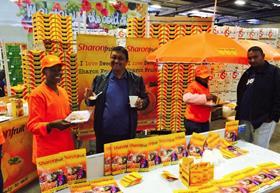
The Sharon Fruit industry was established in South Africa 21 years ago, essentially to provide counter-seasonal fruit when Northern Hemisphere production came to an end. Today, the industry is more mature and fills a vital niche in the country’s fresh produce business.
This is the view of Meir Ben-Artzy, chairperson of Mor International, a founding member of the industry in South Africa. He spoke to Eurofruit on this landmark occasion and says he always believed that once South African consumers got a taste of the fruit, they would be hooked on it.
“We have had to find our feet over the past two decades but I believe we have matured and now offer our supplies to increasing numbers of consumers, both in South Africa and overseas,” says Ben-Artzy. “Of great importance is the fact that Sharon Fruit is now offered at the end of the local South African berry, mango and lychee seasons when there is a real gap for a new exotic product. It is also important that we are finding favour amongst virtually all sectors of South African consumers. Growth in the informal sector is very good and we are expanding every year.”
He says the challenge for the South African Sharon Fruit business is to extend its season. Harvesting normally starts in mid-April and is concluded by mid-May, with sales continuing until July. “Rojo Brilliante, an earlier red variety of Persimmon, is being tested at the moment and will assist us to open the South African season earlier.”
Rojo Brilliante is a persimmon variety with a distinct elongated dome-shape and a smooth, bright orange exterior. High levels of sweetness and flavour and a thin skin make this a very attractive variety. Ben-Artzy says Rojo Brilliante has a somewhat shorter shelf life than Sharon Fruit but, if well handled, it could become an important addition to the South African offer.
While exports continue to be the cornerstone of the South African Sharon Fruit business, it is the growth in the domestic market that Ben-Artzy finds most rewarding. “We have managed to build a strong class two market which assists our growers in marketing a bigger part of their crop economically. We get excellent feedback from consumers and are now represented in both the retail and wholesale sector.”
This year there will be a special focus on the large informal consumer markets in the north of the country. “Sharon Fruit, as is the case with other exotic fruits, are often offered as a plate of six to ten pieces in these markets and this is extremely popular. Our marketing days at the biggest wholesalers in the north are popular events and draw crowds of buyers. The promotional teams are normally on hand and our customers keep coming back for more.”
While Europe remains the most important marketing region for South African Sharon Fruit, the Middle East and Far East are also growing. “In Africa we now also have loyal customers and on the island of Mauritius in the Indian Ocean the taste of Sharon Fruit fits in well with the local demand for exotic products,” Ben-Artzy notes.
There are also renewed efforts to offer South African Sharon Fruit to US consumers. A new shipping link directly between Cape Town and Miami enables the industry to deliver the fruit much quicker to the treatment centre that it has to pass through near Miami. In the past, containers where shipped by Newark and then trucked down to Miami, increasing the transit time considerably.
“We are confident about the future as growers are able to increase their yields and eliminate production problems which are part of the life of fruit growers. We are in production ourselves and that keeps our feet one the ground. Sharon Fruit is now firmly established in South Africa and we are excited about the future,” he concludes.






No comments yet